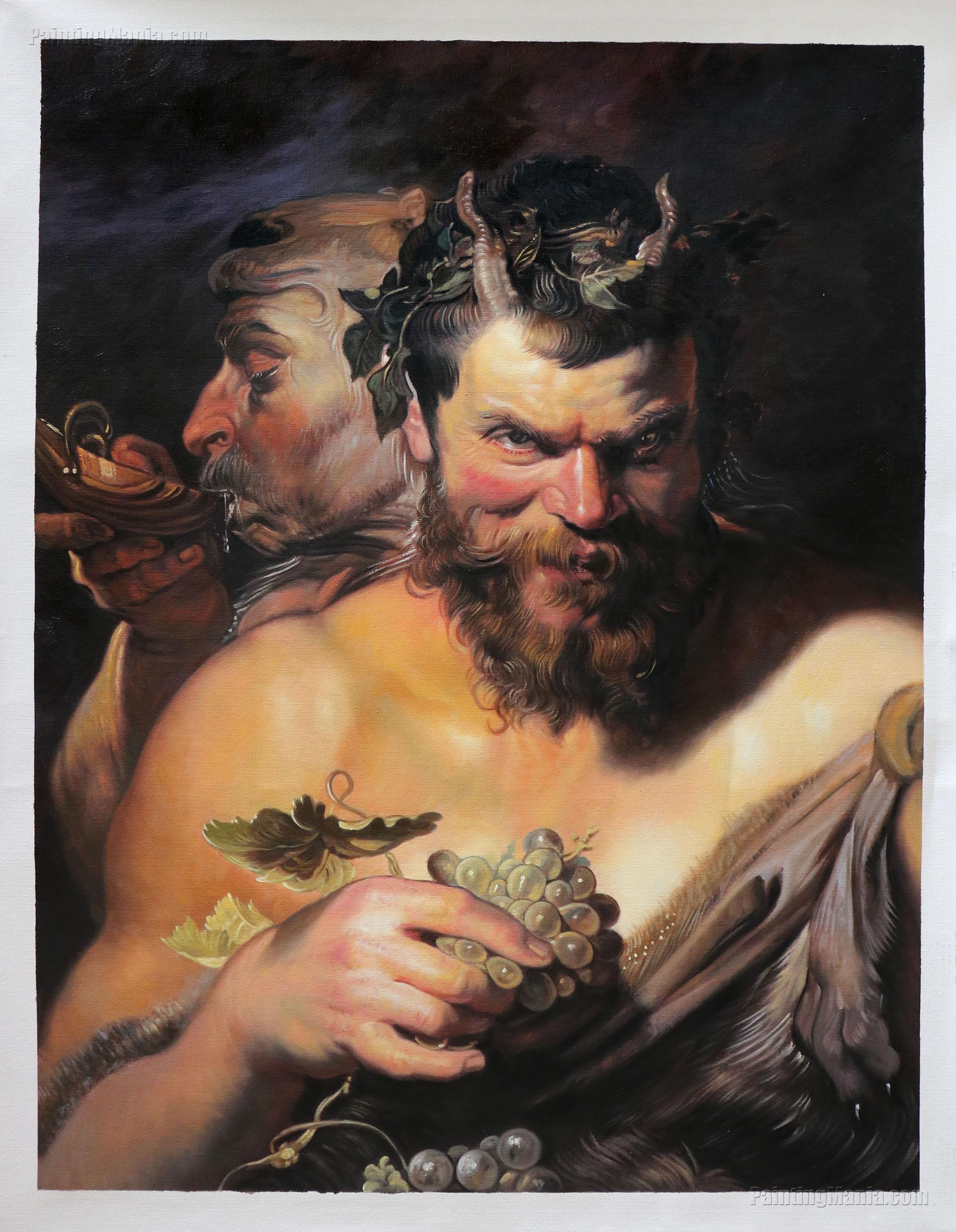
Anyone familiar with classical Greek texts knows that the literature abounds in monstrous or vile creatures whose purpose is to harm human beings, or make their lives miserable, or simply to serve as gross examples of asocial hostility or uncontrolled urges. The murderous Sphinx at the gates of Thebes, along with the bird-like Sirens and filthy Harpies, are prime examples of these horrors.
"The emotionally wild and savage elements, and the non-Greek barbaroi who often embodied them, needed to be strangled if the polis were to be a safe place for human order and achievement."
There are also the Gorgons—freakish females with living snakes instead of hair on their heads. Look at a Gorgon, and her hideous appearance will turn you to stone. This is why the head of the most famous Gorgon, Medusa, was frequently used as an apotropaic device in the ancient world, commonly as the boss on a soldier’s shield, or as the emblem on Athena’s aegis.
Most prominent among the monsters, of course, are the Cyclopes—a savage race of one-eyed giants who represent the complete antithesis to the Hellenic ideal of the civilized human being. The Cyclopes are ugly, stupid, dirty, malodorous, troglodytic, unmannered, rustic, inhospitable, solitary, and impious. In short, they are everything a kalos kai agathos Greek does not want to be. The most celebrated Cyclops, Polyphemus, gets precisely what he deserves when he is rejected by Galatea and blinded by Odysseus. Like Grendel and his mother in Anglo-Saxon literature, the race of the Cyclopes merits extermination.
Human—but monstrous in behavior—are the Amazons: the all-female tribe of warlike archers who murder all their masculine children, and who hack off their own right breasts to allow for a more convenient draw of the bowstring. The Amazons represent a complete rejection of feminine softness, of normal family life, and of the proper subordination of female to male. No wonder their characteristic weapon, the bipennis, has been adopted as a symbol by radical lesbians.
Satyrs and centaurs, who are partially zoomorphic, represent human beings who have allowed their bestial nature and desires to take over and dominate them. A satyr is a goat from the waist down, a physical feature which shows his total enslavement to sexual urges. That is why we term the morbid condition of unrelieved tumescence in males satyriasis, and why Playboy magazine used to have cartoons of satyrs in every issue. Centaurs are half equine, and although highly intelligent (both Achilleus and Aesculapius were trained by centaurs) they too are noted for their lack of sexual restraint and their propensity to violence. The centaur Nessus tried to rape Herakles’ wife; and when a tribe of centaurs was invited to a wedding celebration held by the Greek Lapith clan, they got nastily drunk and attempted to violate the bride. This led to a major brawl between the hosts and their centaur guests, in which most of the latter were killed. In fact, the frequent depiction in Greek art of the bloody battle between the Lapiths and the centaurs has always been understood as a symbol of the righteous triumph of civilization over barbarian savagery.
There are also human beings whose character and typical behavior patterns are anti-civilizational, like the semi-savage Thracians and Cimmerians (or anyone else who was unfortunate enough to be born a barbaros, or non-Greek). The foreign-born Medea, Paris, and Tereus are all instances of vicious or troublemaking outsiders, whose alien cultural presuppositions cause tragedy on a grand scale. Then there are the insane Maenads, who are possessed by the god Dionysos; and Scylla, who devours unwary sailors. And no one can forget the Erinyes, or Furies, who avenge crimes of blood; and Nemesis, who punishes hubris and presumption. All of these are instances of wild emotional seizures that express themselves in rage, and appease themselves with bloodshed.
Silly moderns who idolize the ancient Greeks as benign philosophers who invented nice things like democracy, free thought, and discussion groups are clueless about the above-mentioned forces, and how seriously the Greeks took them. The Greeks may have recognized that satyrs, centaurs, and Cyclopes were mythical, but they knew very well that such imaginary creatures represented subliminal capacities and proclivities in the human soul, and ones that could explode into real-world action at any moment. The entire point of civilized existence was to repress these sick impulses, or else push them to the margins of life, or—if necessary—kill them mercilessly. No debate, no discussion, no polite interaction, no mealy-mouthed compromises. The emotionally wild and savage elements, and the non-Greek barbaroi who often embodied them, needed to be strangled if the polis were to be a safe place for human order and achievement.
The Greeks would have laughed to scorn our brainless multiculturalism, and our sentimental attachment to unrepressed feeling and “the Other.” They had no illusions about their Persian enemies, or the Scythians and Gauls. The Greeks liked studying other cultures, but they didn’t fantasize about the supposed joys of cultural interaction. If they were willing to perpetrate acts of genocidal slaughter against their racial brethren on Melos and Corcyra and Mytilene during the Peloponnesian War, they certainly wouldn’t have hesitated to do the same to non-Greeks.
The Greek divinity that supports order, rationality, and civilizational control is Apollo—the god of supreme intelligence and creative force who comes as a sunburst in the sky, driving away the fog and obscurity of night. He shows the path to all worthy arts and sciences, and to the building of cities. Most importantly, he kills the disgusting dragon at the omphalos, or the center of the world, thereby freeing mankind from a vile plague and annoyance. Apollo is the cold, impersonal archer, the Far Shooter, whose deadly arrows can bring disease but can also destroy without pity or sentimentality all that is low, bestial, filthy, and unworthy of toleration. As I facetiously tell my undergraduate classes, think of Apollo as a spray can of insecticide, killing vermin and other creepy-crawly subhuman garbage.
Whenever you point out the importance of Apollo, people always jump up and object that Dionysos is also a great god in Hellenic culture, and that he is the exact opposite in his drunken wildness and emotional frenzy. They assert that the Greeks equally recognized the right of Dionysos to respect and honor. Euripides’ The Bacchae is always alluded to as a proof of this. Sure, the Greeks honored Dionysos. But they did it in the same frame of mind as a small shopkeeper pays protection money to the local crime syndicate. You honor Dionysos to keep the god off your back, and to survive. You don’t actually like him, any more than you like the god of war, Ares. But you realize that just as the horrid Ares is required in combat, so also is it necessary to tolerate the freaky Dionysos as a kind of safety-valve for the human need to “let loose” every so often. That’s basically it. You require a touch of Dionysos for partying and getting a buzz, and for letting your hair down now and then. But civilization isn’t based on drunken parties or buzz. Dionysian worship is like a string of whorehouses: they are perhaps a bit seedy and disreputable, but it makes good civic sense to have them available and open if society is to run smoothly.
At base, all civilization is concerned with order and the chastisement and marginalization of disorder and alien elements. In the wonderful simile of Cardinal Newman, our civilization is like the impression of a signet seal in hot wax, with a clear configuration and a distinct border, outside of which there is naught but the shapelessness of the alien and the unknown.
The failure to recognize the destructive nature of savagery, unrepressed instinct, the alien, and the uncivilized is a fatal weakness in the minds of those who dominate—both culturally and politically—the modern world. Instead of seeing these evils for what they really are, our elites indulge in pipedreams about how “the Other” is somehow redemptive and fulfilling, and how we must humbly “learn” from it. This naïve fantasy is the emotional engine behind multiculturalism (or as it is now usually called, globalism) and the concomitant impulse to denigrate Western culture and assign it a subordinate place in school curricula. It is behind every literary, academic, or theatrical celebration of the foreign, the freaky, the abnormal, and the sexually perverse.
And this brings us back to the monsters. Who or what is behind our rapidly accelerating cultural degradation? Well, just look at the deracinated freaks who abound in academia, politics, journalism, literature, publishing, business, finance, advertising, and every major institution and foundation. See how chic savagery and glandular instinct are celebrated on every side. See how restraint and order are decried as irksome restrictions. See how “the Other” is worshipped, and our own civilization derided and condemned by its alleged guardians.
None of this is accidental. When the dominant forces in one’s society are modernized versions of centaurs, satyrs, Maenads, Gorgons, Amazons, and Cyclopes, reinforced by imported barbaroi from Third-World cesspools, the situation is desperate. But that’s exactly what the monsters planned, and why they are celebrating.

